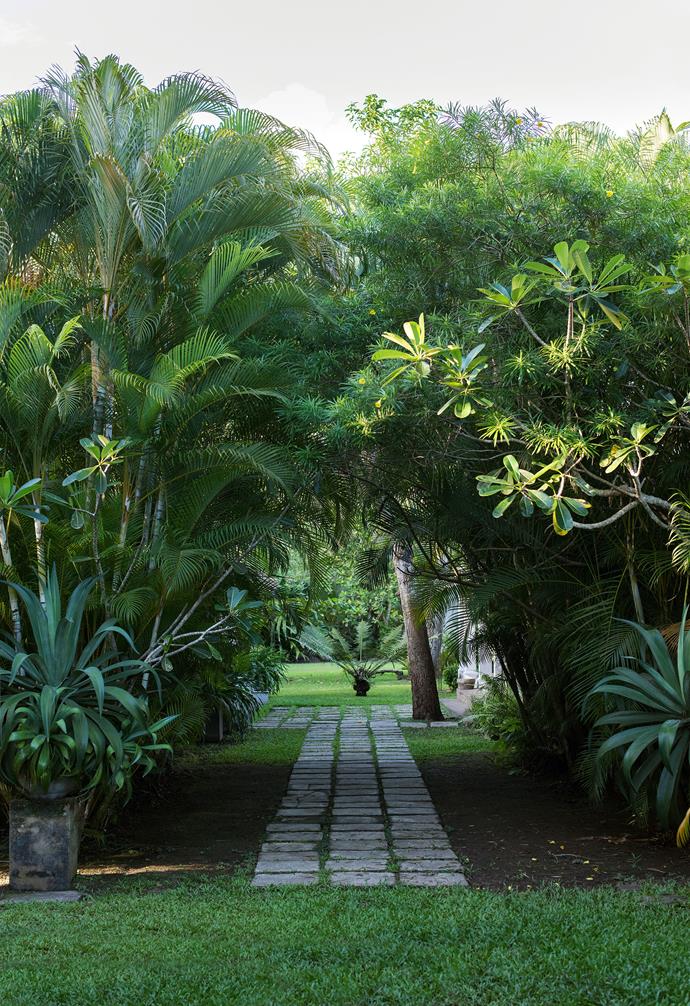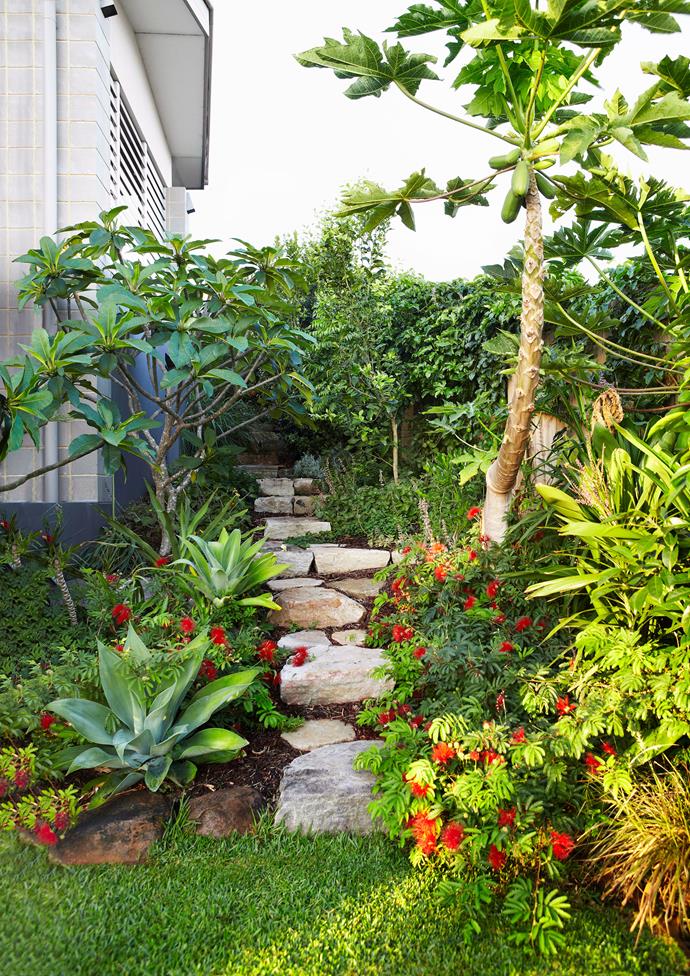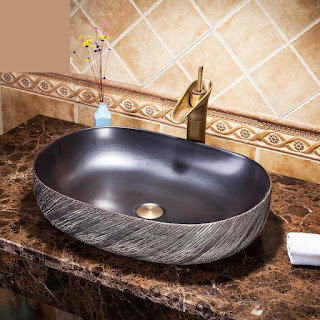You don’t need to travel to a tropical island to escape the pressures of modern life — when you have a resort-style garden, every day is like a holiday.
When you have a tropical garden in your backyard, you don't have to travel to a far-flung island in Asia or the South Pacific to escape the pressures of modern life. With a resort-style garden, every day is like a holiday.
Plus tropical garden design is no longer reserved for just the tropical and subtropical regions of Australia. There's been a growing trend over the last few years around tropical garden plants that will leave your lawns resembling the lush surrounds of a five-star resort.
Whether it's tropical trees, screening plants, or small garden design, we've come up with a guide for everything your need to know about these full-sun loving leaves.
HOW TO DESIGN A TROPICAL GARDEN
Hiring a professional landscape designer is well worth the money — not only is the end result visually alluring, any potential problems can be addressed at the start.
Colourful vistas, linear pathways and focal points create the structure of the garden and help link indoor rooms with outdoor spaces.
Formal paths and straight garden beds contrast with the 'jungle' plantings, while luscious palms, colourful foliage, timber furniture, Balinese lanterns and brightly covered cushions complete the resort style.
First impressions count, so the garden entry is important. Playing with visitors' perceptions is an art and it gives the garden a great sense of fun.
As in life, the journey through our living environments should be as enjoyable as the final destination.
HOW TO LAYER TROPICAL FOLIAGE
For the most part, tropical gardens rely on lush foliage rather than flowers to create interest year round. Foliage should be flamboyant, lively and colourful, and plants must be chosen on the basis of the size, shape and texture of their leaves.
Planting in groups of odd numbers (three, five, seven and nine) is a common trick employed by garden designers — it gives a broad brushstroke of colour and texture, and makes a huge difference to the feel of the garden.
Placing plants with contrasting foliage next to each other will create drama and interest. For maximum impact, position plants with red, yellow, orange, pink, purple and lime-green leaves next to each other.
Colourful flowers, such as fragrant frangipani, ornamental ginger, hibiscus, and dramatic canna lilies will warm up the garden and provide further contrast to the vibrant ground-dwelling foliage and green canopy.
QUICK TROPICAL GARDEN TIPS
- To get a perfect tropical garden, and if budget permits, it's best to consult a professional designer.
- Nothing says 'tropical' like palm trees and bamboo!
- The colour, size, shape and texture of a plant's leaves is important.
- Compost and mulch is essential and replicates what occurs naturally in on a rainforest floor.
TROPICAL TREES FOR BACKYARDS
A selection of perfectly placed palms and bamboo is perfect for achieving a tropical look in your backyard.
Although they're often criticized for growing too big or out of control, palms and bamboo will benefit the style and mood of the garden — they provide the rustle of foliage in the wind, furnish your garden with a fern-like ceiling and dense green walls, and do a great job of privacy screening.
There are a million varieties to choose from, so visit a specialist palm or bamboo nursery where you can seek expert advice. Remember that not all varieties are suited to every climate, and smaller-growing or dwarf specimens are the best choice for courtyards and pocket-sized gardens.
EDIBLE TROPICAL PLANTS TO TRY
If you love to cook, you can even try growing Asian herbs and spices in your tropical garden. Not only do they contribute wonderful flavours and aromas to a wide variety of dishes, they smell fantastic in the garden and help deter pests.
Cardamom, kaffir lime, lemongrass, coriander and mint will grow well among tropical shrubs in cool, moist spots.
Edible ginger (Zingiber officinale) planted in spring will be ready to harvest in March or April — you can simply plant a healthy-looking ginger rhizome from the supermarket. To harvest, you just dig up clumps with a spade.
HOW TO PREP THE SOIL FOR A TROPICAL GARDEN
Gardening in tropical and subtropical areas requires a different approach to gardening in a temperate climate.
Tropical gardeners rarely have to dig down to plant, instead they layer the soil with compost, leaf mould, garden clippings and mulch.
Leaf mulch layering is a process that occurs naturally in forests and gullies, where soil fertility resides in just the top few inches.
HOW TO MAINTAIN A TROPICAL GARDEN
In the tropics, the best time to garden is early morning, before the heat and humidity build up.
Take a stroll around the garden each morning, pruning as you go, and finish at the shredder. All shredded pruning material should be composted, then returned to the garden to maintain the natural cycle.
But don't expect a tropical garden to be maintenance-free. Anyone who gardens in a warm, high-rainfall climate knows that plants explode out of the ground during wet periods.
They must be pruned into submission or they'll take over. (The upside is that many rampant growers can easily be propagated from cuttings or grown from seed.) The need for constant housekeeping means a good pair of secateurs is essential — use them to regularly tidy up any brown foliage, dead palm fronds and spent flowers.
Feed your garden with a mulch of organic manure each spring and spray all the foliage with a seaweed solution once every season to keep the plants robust and strong.
In tropical gardens, it's best to keep the lawn area small — time spent mowing and weeding the lawn is wasted time!
Bright-leafed bromeliads will constantly surprise you with their hardiness and vigour. They flower only once but will continue to grow, sprouting new plants, or 'pups', from the side. When a pup reaches about 10cm, cut it away with a sharp knife, then replant it in pine bark, not soil.
Alternatively, leave the plant to clump naturally. Bromeliads don't have to be planted in the garden, they are just as happy attached to tree trunks or in pots.
Most ornamental gingers die down in winter, and you should remove all the shaggy, dying foliage. When the weather warms up, feed them with aged manure as soon as the new foliage appears. Remember, ginger need regular watering during their growing season.

, with Sedum 'Gold Mound' directly under the palm inset in the paving.](https://d3lp4xedbqa8a5.cloudfront.net/s3/digital-cougar-assets/homes/2022/02/01/1643674740532_1555457042187MIKE5464previewmaxWidth1600maxHeight1600.jpeg?width=690&height=&mode=crop&quality=75)

, now tropical garden.](https://d3lp4xedbqa8a5.cloudfront.net/s3/digital-cougar-assets/homes/2019/02/20/1550622459932_pathway.jpg?width=690&height=&mode=crop&quality=75)

 that will add lush foliage to your outdoor space while providing privacy.](https://d3lp4xedbqa8a5.cloudfront.net/s3/digital-cougar-assets/homes/2019/02/20/1550624255649_bamb.jpg?width=690&height=&mode=crop&quality=75)
 is through a lush tropical garden, dappled with shadows.](https://d3lp4xedbqa8a5.cloudfront.net/s3/digital-cougar-assets/homes/2022/02/01/1643673793100_1575003924456TobiasPartnersHopetounAveVaucluse00206HRpreviewmaxWidth1600maxHeight1600.jpeg?width=690&height=&mode=crop&quality=75)
 is clad in treated and stained hardwood that links the house to its rainforest garden surroundings.](https://d3lp4xedbqa8a5.cloudfront.net/s3/digital-cougar-assets/homes/2022/02/01/1643674267521_151357090997919Edge-of-RainforestMim-Design.jpeg?width=690&height=&mode=crop&quality=75)



Comments
Post a Comment